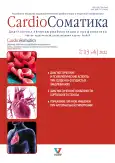Sodium-glucose cotransporter type 2 inhibitors in patients with heart failure with preserved ejection fraction: a systematic review and meta-analysis
- Authors: Mezhonov E.M.1,2, Safiullina Z.M.1, Vyalkina Y.A.1, Shalaev S.V.1,2
-
Affiliations:
- Tyumen State Medical University
- Regional Clinical Hospital No 1
- Issue: Vol 13, No 4 (2022)
- Pages: 198-205
- Section: Original study articles
- URL: https://bakhtiniada.ru/2221-7185/article/view/134166
- DOI: https://doi.org/10.17816/CS121347
- ID: 134166
Cite item
Full Text
Abstract
Background. Epidemiological studies show that mortality among patients with heart failure and preserved left ventricular ejection fraction remains high. In recent clinical studies, inhibitors of sodium-glucose cotransporter type 2 are showing promise in reducing cardiovascular complications in patients with chronic heart failure who need effective drug treatment.
Aim. We aimed to analyze published randomized controlled clinical trials evaluating the effectiveness of sodium-glucose cotransporter type 2 inhibitors, added to standard therapy, in a group of patients with chronic heart failure and a left ventricular ejection fraction over 40%.
Materials and methods. A systematic review and meta-analysis of the scientific literature were performed according to the PRISMA (Preferred Reporting Items for Systematic Reviews and Meta-Analyses) guidelines. A literature search of the PubMed database for the period from January 2021 to December 2022 was performed. The search keywords included the following MeSH terms: “heart failure preserved ejection fraction” or “HFpEF” and “empagliflozin” or “dapagliflozin” or “SGLT2.” The search did not use filters for language or type of study. All statistical analyses were performed using the RevMan version 5.4 (Copenhagen, the Nordic Cochrane Centre, The Cochrane Collaboration, 2014).
Results. The initial search retrieved 481 publications. After further screening and exclusions for non-compliance with the inclusion criteria, two clinical studies were included. There were 12 251 patients in total, 6128 received sodium-glucose cotransporter type 2 inhibitors, 6123 received placebo. Patients treated with these drugs were 20% less likely to have a combined endpoint (odds ratio [OR] 0.80, 95% confidence interval [CI] 0.72–0.87; p <0.001). This was primarily due to a 26% decrease in the frequency of hospitalization for acute decompensation of heart failure (OR 0.74, 95% CI 0.66–0.83; p <0.001). There was a trend toward decreased mortality from cardiovascular causes (OR 0.88, 95% CI 0.77–1.01; p=0.06), while no effect was observed on all-cause mortality (OR 0.96, 95% CI 0.87–1.06; p=0.38).
Conclusions. The meta-analysis shows the potential of sodium-glucose cotransporter type 2 inhibitors to reduce hospitalization for acute decompensation of heart failure in patients with a moderately reduced and preserved left ventricular ejection fraction.
Full Text
##article.viewOnOriginalSite##About the authors
Evgeny M. Mezhonov
Tyumen State Medical University; Regional Clinical Hospital No 1
Author for correspondence.
Email: emmrus@mail.ru
ORCID iD: 0000-0002-6086-4578
SPIN-code: 2935-9617
MD, D. Sci. (Med.), associate professor
Russian Federation, 54 Odesskay Str., 625023, Tyumen; TyumenZemfira M. Safiullina
Tyumen State Medical University
Email: safiullina@tokb.ru
ORCID iD: 0000-0002-6485-1061
SPIN-code: 9112-2130
MD, D. Sci. (Med.), professor
Russian Federation, 54 Odesskay Str., 625023, TyumenYulia A. Vyalkina
Tyumen State Medical University
Email: yulia31052008@yandex.ru
ORCID iD: 0000-0001-6470-5606
SPIN-code: 4237-5048
MD, Cand. Sci. (Med.), associate professor
Russian Federation, 54 Odesskay Str., 625023, TyumenSergey V. Shalaev
Tyumen State Medical University; Regional Clinical Hospital No 1
Email: Shalaev@tokb.ru
ORCID iD: 0000-0003-2724-4016
SPIN-code: 5285-0082
MD, D. Sci. (Med.), Prof., Corresponding Member of RAS, head of the center of the heart and blood vessels
Russian Federation, 54 Odesskay Str., 625023, Tyumen; TyumenReferences
- Dunlay SM, Roger VL, Redfield MM. Epidemiology of heart failure with preserved ejection fraction. Nat Rev Cardiol. 2017;14(10):591–602.doi: 10.1038/nrcardio.2017.65
- Virani SS, Alonso A, Benjamin EJ, et al. Heart disease and stroke statistics – 2020 update: a report from the American Heart Association. Circulation. 2020;141(9):e139–e596. doi: 10.1161/CIR.0000000000000757
- Ponikowski P, Voors AA, Anker SD, et al. 2016 ESC guidelines for the diagnosis and treatment of acute and chronic heart failure: the task force for the diagnosis and treatment of acute and chronic heart failure of the European Society of Cardiology (ESC) developed with the special contribution of the Heart Failure Association (HFA) of the ESC. Eur Heart J. 2016;37(27):2129–2200. doi: 10.1093/eurheartj/ehw128
- McDonagh TA, Metra M, Adamo M, et al. 2021 ESC Guidelines for the diagnosis and treatment of acute and chronic heart failure. Eur Heart J. 2021;42(36):3599–3726. doi: 10.1093/eurheartj/ehab368
- Heidenreich PA, Bozkurt B, Aguilar D, et al. 2022 AHA/ACC/HFSA Guideline for the management of heart failure: a report of the American College of Cardiology / American Heart Association Joint Committee on Clinical Practice Guidelines. J Am Coll Cardiol. 2022;79(17):1757–1780.doi: 10.1016/j.jacc.2021.12.012
- Braunwald E. Gliflozins in the management of cardiovascular disease. N Engl J Med. 2022;386(21):2024–2034. doi: 10.1056/NEJMra2115011
- McMurray JJV, Solomon SD, Inzucchi SE, et al. Dapagliflozin in patients with heart failure and reduced ejection fraction. N Engl J Med. 2019;381(21):1995–2008. doi: 10.1056/NEJMoa1911303
- Packer M, Anker SD, Butler J, et al. Cardiovascular and renal outcomes with empagliflozin in heart failure. N Engl J Med. 2020;383(15):1413–1424. doi: 10.1056/NEJMoa2022190
- Anker SD, Butler J, Filippatos G, et al. Empagliflozin in heart failure with a preserved ejection fraction. N Engl J Med. 2021;385(16):1451–1461.doi: 10.1056/NEJMoa2107038
- Solomon SD, McMurray JJV, Claggett B, et al. Dapagliflozin in heart failure with mildly reduced or preserved ejection fraction. N Engl J Med. 2022;387(12):1089–1098. doi: 10.1056/NEJMoa2206286
- Page MJ, McKenzie JE, Bossuyt PM, et al. The PRISMA 2020 statement: an updated guideline for reporting systematic reviews. BMJ. 2021;372:n71. doi: 10.1136/bmj.n71
- Higgins JPT, Altman DG, Gotzsche PC, et al. The Cochrane Collaboration’s tool for assessing risk of bias in randomised trials. BMJ. 2011;343:d5928. doi: 10.1136/bmj.d5928
- Wilcox JE, Fang JC, Margulies KB, Mann DL. Heart failure with recovered left ventricular ejection fraction: JACC scientific expert panel. J Am Coll Cardiol. 2020;76(6):719–734. doi: 10.1016/j.jacc.2020.05.075
- Bhatt DL, Szarek M, Steg PG, et al. Sotagliflozinin patients with diabetes and recent worseningheart failure. N Engl J Med. 2021;384(2):117–128.doi: 10.1056/NEJMoa2030183
- Voors AA, Angermann CE, Teerlink JR, et al. The SGLT2 inhibitor empagliflozin in patients hospitalized for acute heart failure: a multinational randomized trial. Nat Med. 2022;28(3):568–574. doi: 10.1038/s41591-021-01659-1
Supplementary files











